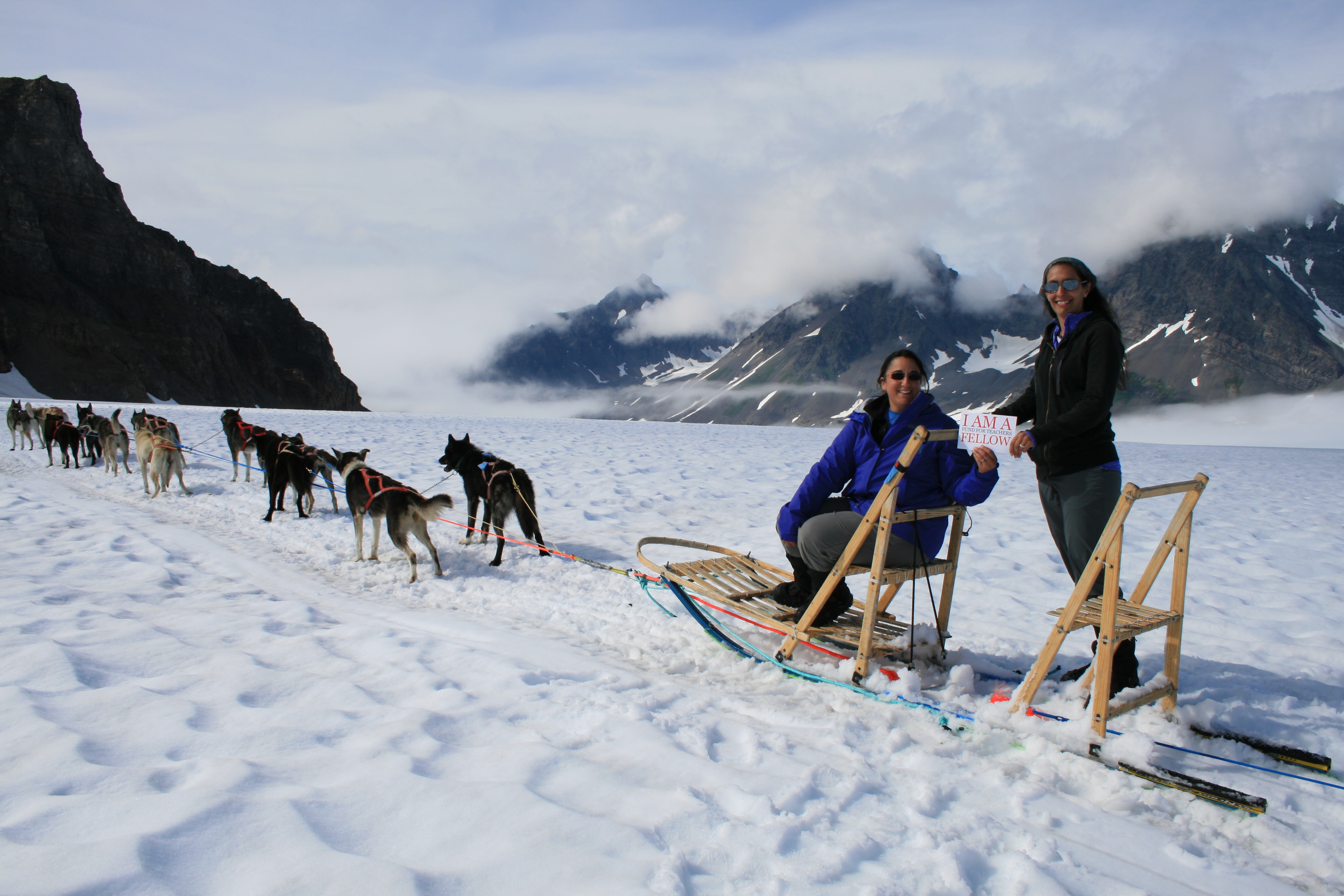Today in History – Alaska!

The name of our 49th state derives from the Aleut word alyeska, or “great land.” Many FFT Fellows would agree after experiencing the culture and ecology of the land that – 151 years ago today – was acquired from Russia for $7.2 million. In celebration of Alaska Day, enjoy the following images, insights and impact of grant recipients’ learning in “The Last Frontier.”
[minti_divider style=”1″ icon=”” margin=”20px 0px 20px 0px”]
2018

Panning for gold in Mineral Creek.
Robin Barboza-Josephson & Catherine Gardner (New Milford High School – New Milford, CT) joined an expedition through the Kenai National Wildlife Refuge and Denali National Park to demonstrate the work of scientists and move ecology education to a model supporting Next Generation Science Standards. (Featured in clip above.)
“We hope to trigger a need for changes in human behavior to try and combat global warming before it is too late. I hope that by sharing my photos and experiences with them, they will realize that their behavior here (4000 miles away) still has an impact on environments they have never seen before.”

Listening to a lecture by Sheeren on Glacier Bay.
Jill Hanley (Journeys Secondary School – Saint Paul, MN) boarded Steve Spangler Science at Sea expedition to the inland passage of South East Alaska to strengthen approaches to Next Generation Science Standards and support student learning surrounding geology, geography, animal science and life cycles.
“I didn’t see Alaska, I experienced it. I went places I had only read about and connected information that I was receiving to the places that I was seeing. The amount of information that Naturalist John Scheeren share with us was amazing. I feel grateful that he shared his knowledge and I can pass his knowledge on to my students.”
Rose Abbey, Sarah Henry-Pratt, LeAnn Olsen & (Oakland Elementary School – Oakland, OR) join the Steve Spangler Science at Sea expedition to the inland passage of South East Alaska to strengthen approaches to Next Generation Science Standards and support student learning surrounding geology, geography, animal science and life cycles. (Featured in clip below.)
“This grant has allowed us as educators to revitalize our way of thinking about instruction in the area of science. We come away from it knowing that science needs to be in every part of our day, not just in science time but also in reading and writing. We know that students need to be engaged to learn. Exposing students to phenomena in science begins the scientific process, and unlocks their interests for the future.”
2017

Christine Dunbar and Charles FitzGibbons (Metropolitan Expeditionary Learning School – Forest Hills, NY) used photo journalism and oral interviews to examine the immediate effects of climate change on coastal Alaskan natives to convey to students the interaction between individuals, communities, government policy and the climate.
“This grant allowed my colleague and me the opportunity to enter into a community and explore the multiple sides of a current event. The content can be examined through both a scientific and political lens, allowing us to create an interdisciplinary case study that can be grounded in both of our classes. Through this process, my horizons have been broadened regarding interdisciplinary content creation through teacher collaboration.”
 Beverly Brotton (Soddy Daisy Middle School – Soddy Daisy, TN) explored Alaska’s landscapes, examining how humans adapt to challenges caused by humanity and nature, to provide students a first-hand account of climate change.
Beverly Brotton (Soddy Daisy Middle School – Soddy Daisy, TN) explored Alaska’s landscapes, examining how humans adapt to challenges caused by humanity and nature, to provide students a first-hand account of climate change.
“There is no way to compare reading about a place and visiting that area. These amazing experiences are a part of me. I can now say I have walked on a glacier, watched a sow play with her cubs in Denali, and ran down a highway to catch a glimpse of a moose drinking from a stream. When you experience it, your arsenal of teachable moments grow.”
 Rebecca Cutkomp (East Hartford High School – East Hartford, CT) explored Washington’s Spokane Indian Reservation and Alaska’s Denali National Park to enrich student learning in thematic units on identity and aid in students’ deeper insight into rhetorical analysis.
Rebecca Cutkomp (East Hartford High School – East Hartford, CT) explored Washington’s Spokane Indian Reservation and Alaska’s Denali National Park to enrich student learning in thematic units on identity and aid in students’ deeper insight into rhetorical analysis.
“My time camping in Alaska looms large in my reflections on my trip. I spent 3 days orienteering through a trail-less section of Denali National Park to mirror the some of the events in John Krakauer’s Into the Wild. I faced some of the obstacles detailed in the book, and while these experiences gave me valuable background knowledge on the text, it also strengthened my understanding of how identity is shaped by our experiences and encounters, a major focus of my fellowship.”

Brandon Hubbard-Heitz and Frank Mangam (The Howard School – Chattanooga, TN) assessed the past and present effects of people’s interaction with the Alaskan wilderness to empower students to embark upon future conservation work in their contexts. (Read more about their learning here.)
“I have a much more nuanced view of the ways in which humans interact with and treat the land on which they live. I believe I am less self-righteous and more able to ask students probing questions, rather than simply argue a point. I believe I am more capable of leading students into the difficult, muddy waters of the debate about climate change and how humans ought to respond to imminent changes to the environment.”
 Back to Blogs
Back to Blogs